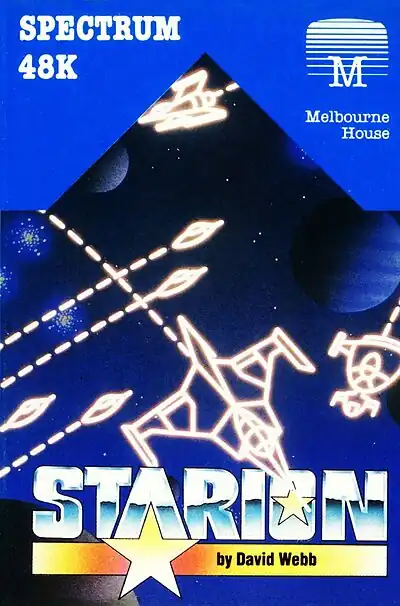Starion

Starion is a wire-frame First-Person Shooter published in 1985 by Melbourne House. It was released on the ZX Spectrum, Amstrad CPC and Commodore 64.
In the year 2010, some time-travelling aliens have decided to mess up Earth's history by stealing important artefacts from various time periods. Each artefact has been moved to a different year and cunningly split into its constituent letters, with each letter stored on a separate alien ship. The protagonist, Starion, is provided with a time-and-space-ship and sent out to do battle with the aliens, reassemble the artefacts and return them to their correct times.
History is arranged in a series of "grids", with a different collection of artefacts jumbled within each grid. For timey-wimey reasons, travel between grids is a One-Way Trip, implying that Starion can never to return to his/her own time.
The game is essentially a flight simulator In Space, with an unusually maneuverable "plane". Once all the letters of an artefact have been collected, there's a brief interlude to figure out the anagram and decide where - sorry, when - the item might belong, then it's back to flying.
Starion was released shortly after Elite, and rumour has it that it was rushed out to compete with that title. Even so, the gameplay is smooth and fast, the wire graphics work well and the game earned some excellent reviews.[1] Including the names and dates of a couple of hundred genuine historical events might even make it count as educational.
- Ambiguous Gender: Starion is a pretty ambiguous name, and the instructions tend to refer to the eponymous character as "you" - which presumably widens the game's appeal.
- Apotheosis: At the end of the game, "you become the earliest thing to exist and must by default assume the ultimate title of CREATOR of all that follows."[2]
- It isn't stated whether you'd actually be able to create anything or do other godly deeds like, y'know, getting yourself home.
- Check Point Starvation: 243 time zones with several dogfights per zone, not to mention figuring out when all the artefacts belong. This is quite a long game for one sitting, but there's no way to save the game, and no way to continue once the lives have run out.
- There is said to be an undocumented save-game feature in the CPC version.
- Covers Always Lie: The original cover art is based around 2D line drawings that look like parts of a diagram, making this a rare example of the in-game graphics being better than the cover.
- Every Ten Thousand Points: Extra fuel is awarded at certain point levels (which depend on the game version, see Unwinnable by Mistake below).
- Teleport Spam: Objects that appear near one corner of either scanner appear to teleport to the opposite side when the ship is turned to face them. This is an unintended consequence of a having a small playing arena in which anything that leaves one side wraps around to the other.
- Porting Disaster: The C64 version suffered from laggy, jerky graphics and bad reviews.
- Timey-Wimey Ball: More of a timey-wimey cube, according to the manual.
- Unwinnable by Mistake: In the original Spectrum release, one bug made it impossible to refuel the ship by landing it while another set the reward threshold too high, so the only way to get more fuel was to get a higher score than was possible to achieve on one tank of fuel.
- Both bugs were fixed in the final release, but it was still unwinnable because one of the later anagrams used 12 letters and the most the program could handle was 11.
- Melbourne House released a patch for the third bug (in the form of a short program to type in), so the patched final version could be won.
- Video Game Lives: Explained in the manual as the ship having several hulls.
- ↑ Although the C64 version is less well animated than the others
- ↑ According to the manual